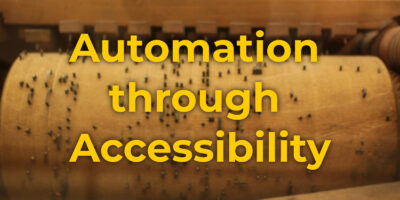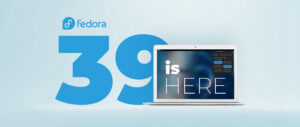Christian Schaller is a long time free software contributor and advocate. He’s also a manager of emerging platform development at Red Hat. The groups in this area include desktop engineering, where developers work on many GNOME features seen in Fedora. Recently Christian posted on his blog about desktop features and improvements users want. He also discussed how Fedora delivers them.
Many such comments came in a recent Hacker News thread concerning Ubuntu. But listening to users doesn’t stop with just Linux users. Christian writes, “I often read such articles and threads about non-Linux systems too, to help understand what people are looking for and thus enable us to prioritize what we do with Fedora Workstation even better.”
Christian goes on to describe several of the most frequent requests. He also describes how Fedora is just offering well integrated technology in these areas to address user needs. More importantly, he discusses how Red Hat invests in these technologies upstream. This helps Fedora deliver a better integrated Workstation, but also brings benefits throughout the Linux community.
He says about leading edge technical features, “by using Fedora you are not only getting access to them first . . . but you are also supporting the effort of moving these technologies forward.” Furthermore, he says, you’re “also putting yourself in a position to more directly interact with the engineers that work on [these features].”
You can read more on Christian’s blog here.






Leslie Satenstein
Hi Paul
I very much appreciated today’s posting. It is great to read about the development activities taking place behind the scenes. The technology research is what drives me to keep with Linux, and specifically, Fedora.
I do have a question, and that has to do with proposal of a place or person to whom we can present New and Improvement ideas. As a 55year + IT experience, I have seen great ideas that disappeared, when they should have become universal.
The ability to present the ideas from end-users as myself could be posted to a forum for discussion. We are the clients, and it is better to have client feedback before a new design is cast in stone.
I have tried to use the fedoraforum.org site to preseent ideas to fellow Fedora users. Some have been responded to as “great”. Others, thumbs down. That forum is not part of the RedHat family. Ditto for the Fedora forum that is based in France.
My belief in life is “No one person has exclusivity on Intelligence”. A similar rule applies to designs and new ideas”.
liam
This is a really good idea, and it wouldn’t be difficult to make, but, for the desktop, it won’t fly.
Fedora, and for that matter Red Hat, doesn’t really have much say when it comes to GNOME.
If you want to see changes you’d have to make them yourself and then convince the desktop team that the patches, which GNOME won’t upstream, are useful and that you can be relied upon to maintain them.
Perspectives
Simply, I agree with Leslie and My back ground is quite similar.
anonymous
I want option in installer to use quake-like terminal, which start by hotkey [~] or [F1]
I want option in installer to make plain FDE without LUKS and to put GRUB bootloader on usb-stick instead of HDD.
I want option in installer to make that plain FDE with FEDORA system to some specific partition on HDD, to use it with other systems.
Andre Gompel
This is for the live version of fedora, on a USB stick.
Instead of the current 4 primary partitions, because they make the unused part of the Flash Drive unusable:
Suggest that the live flash drive partition as a one logical partition, with as many as necessary extended ones.
That will make the rest of the drive, useful by creating other partitions, using for example “gparted”.
An OK alternative, would be to create a simple empty “storage” partition, perhaps formatted as FAT32 ?
Thanks.
A.G
Andre Gompel
My ISP blocks bittorents, and I am not alone ! (very very slow!)
And Fedora 26 alpha X86_64 with LxQt is only available by mean of bittorent.
Please, allows downloading every available ISO image, by using either bittorent or ftp etc…
Thanks
A.G
Tony Rawlings
I use this
Astrill.com
Works in Linux and Windows.
Easy to use.
banany
Gnome only recognizes wacom tablets in Xorg mode. If this could be fixed to work on wayland in Fedora 26, that would be greatly appreciated
Paul W. Frields
@banany: There is work underway on this issue currently upstream, although I don’t know whether it’s scheduled to make Fedora 26.
Jiří Eischmann
Yes, Wacom tablets on Wayland should be supported in F26.
moadeeb
1 – I want support for installing Android applications on Fedora without an emulator or by the easy way.
2. give the portability or flexibility of even a few to control and customize the interface of GNOME without the use of additives
3 – reduce the consumption of the interface of GNOME archers
4 – rewrite the Program Manager for Fedora (yumex-dnf) of a new development .. and fix the problems Software Center GNOME
5. addressing the slow take-off of the Fedora workstation when it is running and stopping work for a while when you log in
IFo Hancroft
The one thing I would most like to see is a quick and easy way to disable mouse acceleration.
xinput shows devices twice and the config setting the props to disable acceleration seem to be applied to only one instance of the device.
This brings the following frustrations:
Is acceleration really disabled for the device?
Do I need to disable the second instance of the device in order for it to not be accelerated?
I thought setting AccelerationProfile to -1 is enough but if wott hadn’t told me, I wouldn’t have known that I also need to set AccelerationScheme to none.
I would love to see a quick and easy way to disable mouse acceleration (it doesn’t have to be for all mice, it can be per mice) that remains after reboot. Even if my current method is working, I am not exactly sure as there is too much frustration whether the appropriate way of doing it and because of the device showing twice, slightly differently under xinput and one instance not seeming to catch on the settings.
It would be nice to also see xinput showing devices properly (just once) and not showing a keyboard as a pointer device or mouse under keyboard devices etc.
Paul W. Frields
Can this not be done with the Mouse settings panel? If I move the acceleration slider all the way to the left, the result seems consistent here with no mouse acceleration, and it sticks to my user account.
IFo Hancroft
I am not sure this disables it completely, as opposed to just lowering it or putting the multiplyer to 1. Also not all mouse settings panels are equal so this may work in one desktop environment but not in another.
Claude
“He says about leading edge technical features, “by using Fedora you are not only getting access to them first . . . ”
Ubuntu already has Gnome 3.24, which Fedora will have in Fedora 26 this summer. By fall, Ubuntu will have Gnome 3.26. Sorry, but no, you won’t have them first by using Fedora anymore.
Paul W. Frields
Ah, but there’s also Rawhide, and the test releases. Fedora is doing work now to make Rawhide more runnable by non-experts. And don’t forget, Fedora ships upstream with as few patches as possible (often none), so the integration is what’s intended upstream. This gets important when you start figuring in numerous subsystems like udev, NetworkManager, etc.
Ryan Lerch
Note, however too that not all the apps included in Ubuntu GNOME are the 3.24 versions ( https://wiki.ubuntu.com/ZestyZapus/ReleaseNotes/UbuntuGNOME )
on Ubuntu GNOME 17.4, GNOME Software and the Evolution stack are 3.22, and Files(Nautilus), anf GNOME Terminal are both the 3.20 versions on Ubuntu.
moadeeb
GNOME Tweak Tool should be integrated with gnome by default and should developed it tools by added more features
Why fedora take long time in start ? this problem Suffer and Facing a lot of users
By the way, I appreciate your efforts very much
My compliments and thanks to you